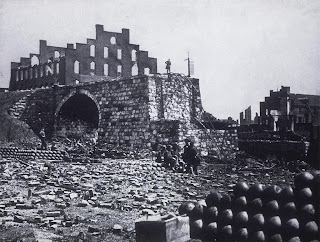By early spring 1865 the citizens of Richmond had become used to the threat of capture by the Federal army whose soldiers the Richmond newspapers described with great imagination as the vilest of humanity. Richmond had endured some frighteningly close chances, and its inhabitants had grown accustomed to the sound of artillery fire from just ten miles outside the city. Their faith in Robert E. Lee was so complete that they knew beyond the shadow of a doubt that he would never allow Richmond to be taken.
Confederate President Jefferson Davis had discussed the probability of quitting Richmond with Lee a month earlier, and he had already sent his wife and family out of the city. Despite these precautions, Davis still believed Lee could stave off disaster.
On Sunday, April 2, the evacuation of Richmond was not anticipated even by President Davis, who was attending service at St. Paul's. At 12 o'clock a dispatch was received from Lee and handed to the President, while in church, to the effect that Lee's line, had been pierced in two places and it would be necessary to evacuate the city that night.
Official word of the Confederate government's departure was finally announced at 4 o'clock. Lawley reported: "The scene that followed baffles description. During the long afternoon and throughout the feverish night, on horseback, in every description of cart, carriage, and vehicle, in every hurried train that left the city, on canal barges, skiffs, and boats, the exodus of officials and prominent citizens was unintermitted."
On Sunday, April 2, the evacuation of Richmond was not anticipated even by President Davis, who was attending service at St. Paul's. At 12 o'clock a dispatch was received from Lee and handed to the President, while in church, to the effect that Lee's line, had been pierced in two places and it would be necessary to evacuate the city that night.
Official word of the Confederate government's departure was finally announced at 4 o'clock. Lawley reported: "The scene that followed baffles description. During the long afternoon and throughout the feverish night, on horseback, in every description of cart, carriage, and vehicle, in every hurried train that left the city, on canal barges, skiffs, and boats, the exodus of officials and prominent citizens was unintermitted."
Davis, his Cabinet, and the Confederate defenders abandoned Richmond and fled south on the last open railroad line. The retreating soldiers were under orders to set fire to bridges, the armory, and warehouses with supplies as they left. The fire in the largely abandoned city spread out of control, and large parts of Richmond were destroyed, reaching to the very edge of Capitol Square mostly unchecked. The conflagration was not completely extinguished until the mayor and other civilians went to the Union lines east of Richmond and surrendered the city on April 3. Union troops put out the raging fires in the city. The event became known as the Evacuation Fire of 1865.
"I cannot begin to describe to you the terrors of that day. It can only be likened to my conception of the Judgement Day. At no time during the war did the fiercest artillery duel equal in bursting of shell the firing of the Laboratory. Every second there was a discharge of shell from early morn to late in the evening to the great danger of the lives of all who lived in the direction of the building. . . . I scarcely know how to describe to you the extent of the fire so that you will understand it. The whole business part of the City from 9 to 15th St. is in ashes. . . . All of the bridges were destroyed. It will be necessary for you to see the ruins to fully understand the extent of this fire. . . . The result has been just what I predicted three years ago, that when Richmond was given up it would be the death blow to the Confederacy. I did not think however that it would follow soon. " ~Oscar F. Weisiger














No comments:
Post a Comment